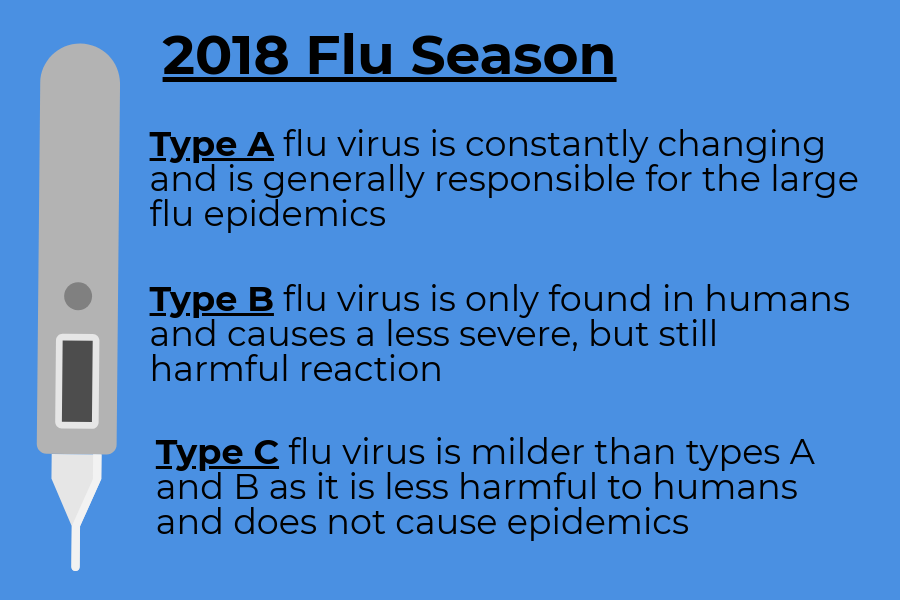Flu Epidemic Stronger in 2018 Than Previous Years
March 23, 2018
Germs are everywhere. They spread from the air to the ground and are nearly impossible to avoid. This late winter season has been infected with an influx of sick students and staff due to bacteria from influenza at a level rarely seen.
Influenza, commonly known as the “flu,” is an extremely contagious respiratory illness caused by type A, B and C viruses. The flu appears most frequently in winter and early spring. The virus attacks the body by spreading through the upper and/or lower respiratory tract.
Type A flu virus is constantly changing and is generally responsible for the large flu epidemics as it spreads by infected people and animals. Type B flu virus is only found in humans and causes a less severe, but still harmful reaction. Type C flu virus is milder than types A and B as it is less harmful to humans and does not cause epidemics.
The flu spreads by coming into contact with the residue of someone else’s sneeze or cough. Once someone starts touching their nose, eyes or mouth, it grows even more difficult to avoid catching their germs.
This year’s flu season caught many experts by surprise and in addition to garnering national attention, many schools have been struggling with students and staff out sick and often spreading the flu.
The season’s not over but we’re definitely on the downward trend right now.
“Hospitalization rates for flu this season are, as usual, highest among people over age 65, CDC [Center for Disease Control] reports. The next hardest-hit groups are adults age 50 to 64 and children under age four,” according to a Jan. 22 article in USA TODAY.
Students who caught the the Influenza B virus exhibited symptoms such as fever, coughing, headaches and much more.
“I wasn’t in school for a whole entire week,” sophomore Joey Emond said. “It was a terrible experience for me since I spent my school days resting and laying in bed all day.”
Although the symptoms can be similar to the common cold, the flu is much more severe. As of the beginning of March, the CDC has reported over 230,000 cases this flu season.
While this flu season is not over yet, it is beginning to show some signs of relenting.
“Public health officials have said this flu season is likely to continue until mid-April, and the intensity of illness has made it the worst since the swine flu pandemic of 2009-2010. An additional 17 child deaths were reported across the country for the week ending Feb. 24,” according to a March 2 article in The Washington Post.
While more than 100 different viruses can cause a cold, only influenza virus types A, B and C cause the flu. Students and staff have been directly impacted by this intense flu season as it spreads throughout hallways and classrooms where students and teachers are in close proximity and easily transmit germs.
School Nurse Joan Grocki has been taking care of sick students who come to her office by providing fluids and taking temperatures.
“We recommended students to go to their doctors or not come to school when they aren’t feeling well,” Grocki said. “However they sometimes tend to not listen which helps spread germs around the school.”
Grocki added that building service workers have been sanitizing the school by spraying disinfectant in the office and wiping down the doorknobs to prevent germs from spreading around the school. Despite numerous efforts, music teacher Nicole Sherlock was one of the staff members who caught the flu.
“It wasn’t pleasant–that I’ll say about my experience,” Sherlock said. “My doctor didn’t want me to get more sick if I went to her office.”
As March continues, the number of flu patients is slowly decreasing, including a decline in deaths from the flu and pneumonia.
“The season’s not over but we’re definitely on the downward trend right now,” the CDC’s acting director Dr. Anne Schuchat told the Associated Press.




